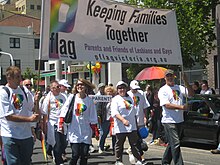Straight ally


A straight ally or heterosexual ally is a heterosexual and cisgender person who supports equal civil rights, gender equality, LGBT social movements, and challenges homophobia, biphobia and transphobia. Despite this, some people who meet this definition do not identify themselves as straight allies. A straight ally believes that LGBT people face discrimination and thus are socially and economically disadvantaged. They aim to use their position as heterosexual or cisgender individuals in a society focused on heteronormativity to fight homophobia, biphobia and transphobia.[citation needed]
Most LGBT organizations have straight members involved; others actively encourage straight participation. A gay–straight alliance is a student-run club that brings together LGBT and straight students to create a platform for activism to fight homophobia and transphobia.[1] There are also some groups that unite the LGBT community to work together with straight allies. Founded in 1973, Parents, Families and Friends of Lesbians and Gays (PFLAG) is the original straight ally organization, started by Jeanne Manford, mother of the Straight Ally movement. Based in the United States, PFLAG unites parents, families, friends, and straight allies with the LGBT community to move equality forward for LGBT people. In 2007, the organization launched a new project, Straight for Equality[2] to help more straight allies become engaged in the LGBT movement in the workplace, healthcare, and now in faith communities. Gay & Lesbian Advocates & Defenders (GLAD) is another organization specifically formed to group allies of this cause.[citation needed]
Some children of LGBT couples are straight allies, notably Iowan Zach Wahls, the son of two lesbians, though he has expressed a different view of his relationship to the LGBT community:[3]
To be clear, I don't consider myself an ally. I might be [a] straight cisgender man, but in my mind, I am a member of the LGBT community. I know the last thing that anyone wants is to add another letter to the acronym, but we need to make sure as a movement we're making a place for what we call "queer-spawn" to function and to be part of the community. Because even though I'm not gay, I do know what its like to be hated for who I am. And I do know what its like to be in the closet, and like every other member of the LGBT community, I did not have a choice in this. I was born into this movement.
Straight allies may receive criticism for a variety of reasons. For example, some believe that straight allies are unable to step outside their own heteronormative world to advocate.[4] Straight allies are also criticized for using LGBTQ advocacy as a means to gain popularity and status.[5]
See also
- Athlete Ally
- Atticus Circle
- Gay & Lesbian Alliance Against Defamation (GLAAD)
- Homophile
- Human Rights Campaign – General human rights
- Human rights in the United States
- LGBT rights in the United States
- Straight Alliance for LGBT Equality in Russia
References
- ^ "What We Do: Gay-Straight Alliance". Gsanetwork.org. Retrieved 2011-07-21.
- ^ "Straight for Equality website". Straightforequality.org. Retrieved 2013-08-17.
- ^ Washington Blade: Phil Reese, "'That kid from YouTube'," May 23, 2012, accessed June 2, 2012
- ^ DeTurk, Sara (2011). "Allies in Action: The Communicative Experiences of People Who Challenge Social Injustice on Behalf of Others". Communication Quarterly. 59 (5): 569–590. doi:10.1080/01463373.2011.614209.
- ^ Becker, Ron (2006). "Gay-Themed Television and the Slumpy Class: The Affordable, Multicultural Politics of the Gay Nineties". Television News Media. 7: 184–215. doi:10.1177/1527476403255830.
External links
- Straight for Equality—a straight ally organization
- Human Rights Campaign (a gay rights organization) on being a straight ally
- Atticus Circle—a straight ally organization
- Allies Out For Change—a straight ally organization
